de Havilland DH.88 Comet
| DH.88 Comet | |
|---|---|
 | |
| G-ACSS Grosvenor House during a display at the Shuttleworth Collection in 2014 | |
| Role | Racing aircraft |
| Manufacturer | de Havilland |
| Designer | A. E. Hagg |
| First flight | 1934 |
| Status | One airworthy; one in restoration |
| Number built | 5 |
The de Havilland DH.88 Comet is a two-seat, twin-engined aircraft developed specifically to participate in the 1934 England-Australia MacRobertson Air Race from the United Kingdom to Australia.
Development of the DH.88 Comet was initiated at the behest of British aviation pioneer Geoffrey de Havilland, along with the support of de Havilland's board, being keen to garner prestige from producing the victorious aircraft as well as to gain from the research involved in producing it. The Comet was designed by A. E. Hagg around the specific requirements of the race; Hagg produced an innovative design in the form of a stressed-skin cantilever monoplane, complete with an enclosed cockpit, retractable undercarriage, landing flaps, and variable-pitch propellers.
A total of three Comets were produced for the race, all for private owners at the discounted price of £5,000 per aircraft. The aircraft underwent a rapid development cycle, performing its maiden flight only six weeks prior to the race. Comet G-ACSS Grosvenor House emerged as the winner. Two further examples were later built. The Comet went on to establish a multitude of aviation records, both during the race and in its aftermath, as well as participating in further races. Several examples were bought and evaluated by national governments, typically as mail planes. Two Comets, G-ACSS and G-ACSP, survived into preservation, while a number of full-scale replicas have also been constructed.
The Great Air Race
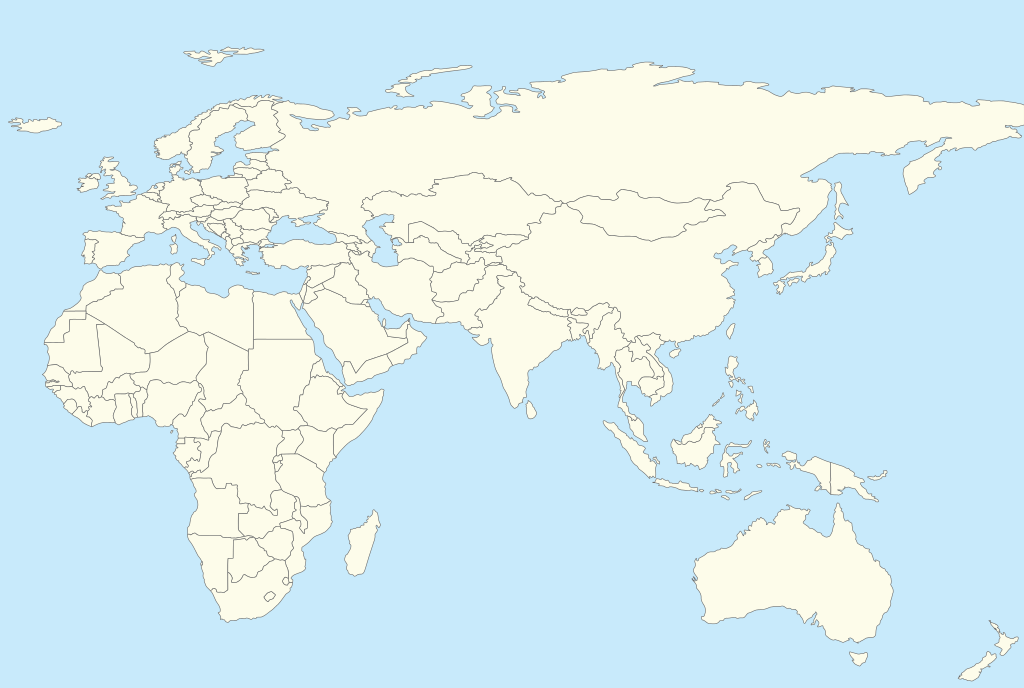
During 1933, the MacRobertson Air Race, a long distance multi-stage journey from the United Kingdom to Australia, was being planned for October 1934, to celebrate the 100th anniversary of the Australian State of Victoria. Sponsored by Macpherson Robertson, an Australian confectionary manufacturer, the race would be flown in stages from a new aerodrome at Mildenhall to Melbourne.[1][2][3]
Despite a number of previous air racing successes by British companies, a new generation of monoplane airliners that were then being developed in America had no viable rival in Britain at the time. Geoffrey de Havilland, a British aviation pioneer and founder of aircraft manufacturing firm de Havilland, was determined that the MacRobertson Air Race ought to be won by a British aircraft.[4] While it was recognised that there would be no prospect of recouping the full investment in developing a new design, the De Havilland board decided to subsidise the project; it was hoped that the endeavour would serve to both enhance the company's prestige and also provide benefits that would result from the research involved.[5]
Accordingly, it was announced in January 1934 that if three orders could be obtained by 28 February, a specialist racer to be named the Comet would be built and sold for £5,000 each, that would be capable of achieving a guaranteed speed of 200 miles per hour (320 km/h).[6] This price was estimated as being half of the cost of manufacture. Three orders were indeed received by the deadline; one from Jim Mollison, to be flown by him and his wife Amy (better known as Amy Johnson), one from A. O. Edwards, a hotel manager, and the last from racing motorist Bernard Rubin.[7]
Design and development
Although designed around the requirements for the MacRobertson race, owing to its unusual requirements the Comet did not fit the standard technical specification for a Racing aircraft, nevertheless it was classed as a "Special, sub-division (f), Racing or Record".[8] De Havilland paid special attention to the non-stop range necessary for the long official stages. They initially intended to produce a twin-engined two-seat development of the DH.71 experimental monoplane. However, it would have insufficient performance so the designer, A. E. Hagg, turned to a more innovative design, this being a new cantilever monoplane with enclosed cockpit, retractable undercarriage and flaps. In order to achieve take-off at a reasonable speed and with high all-up weight, combined with a satisfactory high-speed cruise, it would be necessary to fit variable-pitch propellers.[9]
The resulting design had a low, tapered high aspect ratio wing and was powered by two Gipsy Six R engines, a specially-tuned version of the new Gipsy Six. Construction was almost entirely of wood, metal being confined to high-stress components such as the engine bearers and undercarriage, and to complex curved fairings such as the engine cowlings and wing root fairings. The sheet metal parts were of lightweight magnesium-aluminium alloy. Manually operated split flaps were fitted below the wing inboard rear sections and lower fuselage, while the Frise ailerons were mass balanced by lead strips within the wing's leading edges. The rudder and elevators fitted to the conventional tail had horn mass balances. In order to prove the wing design a half-scale model wing was built and tested to destruction.
Aerodynamic efficiency was the design priority and it was therefore decided to use a thin wing of RAF34 section. This was not thick enough to contain spars of sufficient depth to carry the flight loads and so the wing skin would have to carry most of the loads. However, the complex curves required for aerodynamic efficiency could not be manufactured using plywood. Hagg, who also had experience as a naval architect, adapted a construction technique previously used for building lifeboats. The majority of the wing was covered using two layers of 2 inch (50mm) wide spruce planking laid diagonally across the wing, with the outer layer laid crosswise over the inner. These strips were of variable thickness, according to the loads they carried, reducing over the span of the wing from 0.5 in (12.5mm) at the root to 0.14in (3.5mm) towards the tips. It was built as a single assembly around three box-spars located at 21, 40 and 65 percent chord: there was an intermediate spruce stringer between each pair of spars to prevent buckling. The ribs were made of birch ply and spruce. The outboard 6 ft (1.5m) were skinned with various thicknesses of ply because of the difficulty of machining spruce planking to less than 0.07in thickness. The leading edge, forward of the front spar, was also ply covered. The centre section was reinforced with two additional layers of 0.07 spruce.[10] This method of construction had been made possible only by the recent development of high-strength synthetic bonding resins and its success took many in the industry by surprise.[11]

The fuselage was built principally from plywood over spruce longerons, while the upper and lower forward section were built up from spruce planking in order to achieve the necessary compound curves. As with the wing, the strength of the structure was dependent upon the skin. Fuel was carried in three fuselage tanks. The two main tanks filled in the nose and centre section in front of the cockpit. A third auxiliary tank, of only 20 gal capacity, was placed immediately behind it and could be used to adjust the aircraft's trim. The pilot and navigator were seated in tandem in a cockpit set aft of the wing. While dual flight controls were fitted, only the forward position had a full set of flight instruments.
The engines were uprated versions of de Havilland's newly developed Gipsy Six, race-tuned for optimum performance with a higher compression ratio. The DH.88 could maintain altitude up to 4,000 feet (1,200 m) on one engine. The main undercarriage retracted backwards into the engine nacelles and was operated manually, requiring 14 turns of a large handwheel located on the right hand side of the cockpit.[7]
The challenging production schedule meant that flight tests of the DH.88 began just six weeks prior to the start of the race. Hamilton-Standard hydromatic variable-pitch propellers were initially fitted. During testing, the propeller blade roots were found to interfere unacceptably with the airflow into the engine. Instead, a French two-position pneumatically-actuated Ratier type was substituted.[12] Its blades were manually set to fine pitch before takeoff using a bicycle pump, and in flight they were repositioned automatically to coarse (high-speed) pitch via a pressure sensor. A drawback was that the propellers could not be reset to fine pitch except on the ground.[12] Other changes included the installation of a large landing light fitted in the nose and a revised, higher profile to the cockpit to give the pilot marginally less restricted visibility.
Operational history
MacRobertson Race
All three Comets lined up for the start of the race at Mildenhall, a newly established airfield in Suffolk shortly to be handed over to the RAF. G-ACSP was painted black and named Black Magic, G-ACSR green and unnamed, G-ACSS red and named Grosvenor House. The three aircraft took their places among 17 other entrants, which ranged from new high-speed Douglas DC-2 and Boeing 247 airliners to old Fairey Fox biplanes.
G-ACSP Black Magic
Jim Mollison and his wife Amy (born Amy Johnson) were both famous aviators in their own right and had earned the nickname "the flying sweethearts". They were favourites to win the race in their own G-ACSP Black Magic and were the first entrants to take off.
At 6.30 a.m. on 20 October 1934, they began a non-stop leg to the first compulsory staging point at Baghdad, the only crew who managed to do so without stopping to refuel. Arriving next at Karachi they set a new England-India record. Problems began when their landing gear failed to retract and, after returning to Karachi for repairs, they were again delayed by difficulties with navigating at night. Worse problems followed when they made an unscheduled refuelling stop at Jabalpur but found no aviation fuel. Running instead on unsuitable fuel provided by the local bus company, a piston seized and an oil line ruptured. They flew on to Allahabad but, by now needing completely new engines, were forced to retire.
G-ACSS Grosvenor House
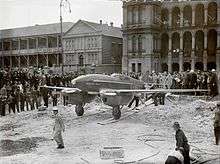
A. O. Edwards named his red Comet G-ACSS after the Grosvenor House Hotel which he managed. He engaged C. W. A. Scott and Tom Campbell Black to fly it in the race.
Having landed at Kirkuk to refuel, they arrived at Baghdad after the Mollisons had left but took off again after a fast half-hour turnaround. This time it was Scott and Campbell Black who missed out Karachi and flew non-stop to Allahabad. There they were told they were the first to arrive – they had overtaken the troubled Mollisons. Despite a severe storm over the Bay of Bengal, in which both pilots had to wrestle with the controls together, they reached Singapore safely, eight hours ahead of the DC-2.
They took off for Darwin, losing power in the port engine over the Timor Sea when the oil pressure dropped to zero, but struggled on to Darwin. While mechanics were working on the engine its designer, Frank Halford, saw a news placard back in England and telephoned through to Darwin. Talking it over he concluded that, despite the warning indicator, they should be able to fly on at reduced power. Despite this their lead was now unassailable and after the final mandatory stop and more engine work at Charleville they flew on to cross the finish line at Flemington Racecourse at 3.33 p.m. (local time) on 23 October. Their official time was 71 hours 18 seconds.
G-ACSR
The third Comet, G-ACSR had been painted in British racing green by Bernard Rubin who was a successful motor race driver. He had intended to fly it himself along with Ken Waller but had to pull out at the last minute due to ill health and instead engaged Owen Cathcart Jones to take his place.
On reaching Baghdad, they overshot it in the dark, landing by a village when they ran low on fuel. Leaving at first light, they just made it to Baghdad on empty tanks. On taking off again they found that they had a serious oil leak and had to return for repairs. These repairs were carried out by T.J. Holmes RAF (while in Baghdad on RAF secondment. More trouble was encountered on the Darwin leg so they landed at Batavia, where engineers employed by KLM, who had entered the DC-2, kindly made repairs for them. They were the fourth aircraft to reach Melbourne, in a time of 108 h 13 min 45 s. Cathcart Jones and Waller promptly collected film of the Australian stages of the race and set off the next day to carry it back to Britain. Their return time of 13½ days set a new record.
After the race
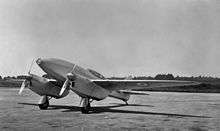

Grosvenor House was dismantled and shipped back to England. It was later bought by the Air Ministry, given the military serial K5085, painted silver overall with RAF markings and flown to Martlesham Heath for evaluation. It made several flights before being written off in a heavy landing and sold for scrap. It was subsequently sold on, rebuilt and fitted with Gypsy Six series II engines and a castoring tailwheel. In this form it made several race and record attempts under various names. It claimed fourth place in the 1937 Istres-Damascus-Paris race and later the same year lowered the out-and-home record to the Cape to 15 days 17 hours. In March 1938, A. E. Clouston and Victor Ricketts made a return trip to New Zealand covering 26,450 mi (42,570 km) in 10 days 21 hours 22 minutes.[13][14]
In G-ACSR, the day after they finished the race Cathcart Jones and Waller took off on the return journey. Suffering engine trouble, at Allahabad they found the Mollisons still there and were generously given two good pistons from Black Magic to allow them to continue. Arriving back in England they set a new round-trip record of 13 days, 6 hours and 43 minutes. That December, named Reine Astrid in honour of the Belgian queen, G-ACSR was flew the Christmas mail from Brussels to Leopoldville in the Belgian Congo.[7] It was then sold to the French government and modified as mail plane F-ANPY, its delivery flight setting a Croydon-Le Bourget record on 5 July 1935. It subsequently made Paris–Casablanca and Paris—Algiers high-speed proving flights. Formerly believed destroyed alongside F-ANPZ (see below), F-ANPY was last seen in an unflyable condition at Étampes in France in 1940.[15]
Black Magic was sold to Portugal for a projected flight from Lisbon to Rio de Janeiro. Re-registered CS-AAJ and renamed Salazar it was damaged on its attempted takeoff for the Atlantic crossing and was returned for repair. On its return it made a record flight from London to Lisbon, setting a time of 5 hr, 17 min in July 1937, but failed to make any further significant flights.
Other Comets
Following the French government's acquisition of F-ANPY (see above), they ordered a fourth Comet, F-ANPZ, with a mail compartment in the nose. It was later taken on charge by the French Air Force before being destroyed in a hangar fire at Istres in France in June 1940.[15]
The fifth and last Comet, registered G-ADEF and named Boomerang, was built for Cyril Nicholson. It was piloted by Tom Campbell Black and J. C. McArthur in an attempt on the London-Cape Town record. It reached Cairo in a record 11 hr, 18 min, but the next leg of the journey was cut short due to oil trouble while in flight over the Sudan. G-ADEF crashed and was lost on 22 September 1935, the crew escaping by parachute.[7]
Record flights
The de Havilland Comets set many record times for long-distance flights during the 1930s, both during races and on special record-breaking flights.
| Date | Aircraft | Crew | Route | Distance | Time | Notes |
|---|---|---|---|---|---|---|
| 20–21 October 1934 | G-ACSP | Jim and Amy Mollison | England–Karachi | During the MacRobertson air race | ||
| 20–23 October 1934 | G-ACSS | C. W. A. Scott and Tom Campbell Black | England–Australia | 11,000 miles (18,000 km) | 70 hr 55 min | Winner of the MacRobertson air race |
| 20 Oct–2 Nov 1934 | G-ACSR | Owen Cathcart Jones and Ken Waller | England–Australia–England | 22,000 miles (35,000 km) | 13 days 6 hr 43 min | First leg during the MacRobertson air race |
| 20 December 1934 | G-ACSR | Ken Waller and Maurice Franchhomme | Brussels–Belgian Congo–Brussels | 882 miles (1,419 km) | 44 hr 40 min | Intermediate records set along the way. |
| 26 February 1935 | CS-AAJ | Carlos Bleck and Costa Macedo | London–Lisbon | 1,010 miles (1,630 km) | 6 hr 30 min | [16] |
| 11 April 1935 | F-ANPY | Hubert Buckingham and Martin Sharp | Croydon–Le Bourget | 205 miles (330 km)[17] | 56 min | [16] |
| 5 July 1935 | F-ANPZ | Hubert Broad | Croydon–Le Bourget | 205 miles (330 km)[17] | 50 min | [16] |
| 1–2 August 1935 | F-ANPY | Jean Mermoz and Léo Gimié[16] | Paris–Casablanca–Dakar | 2,990 miles (4,810 km) | 15 hr 41 min | Faster still on the return journey. |
| September 1935 | F-ANPY | Jean Mermoz and Léo Gimié | Paris–Algiers | 8 hr 38 min | [16] | |
| July 1937 | CS-AAJ | Costa Macedo | London–Lisbon | 1,010 miles (1,630 km) | 5 hr 27 min | Breaking its own previous record |
| 14–16 November 1937 | G-ACSS | A.E. Clouston and Betty Kirby-Green | London–Cape Town | 7,200 miles (11,600 km) | 45 hr 2 min | Named The Burberry. |
| 18–20 November 1937 | G-ACSS | A.E. Clouston and Betty Kirby-Green | Cape Town–London | 7,200 miles (11,600 km) | 57 hr 23 min | Return trip. |
| 15–20 March 1938 | G-ACSS | A.E. Clouston and Victor Ricketts | London–New Zealand | 13,179 miles (21,210 km) | 104 hr 20 min | Named Australian Anniversary. |
| 20–26 March 1938 | G-ACSS | A.E. Clouston and Victor Ricketts | New Zealand–London | 13,179 miles (21,210 km) | 140 hr 12 min | Return leg, completing the first ever round trip. |
Surviving aircraft
.jpg)
G-ACSS was requisitioned for the RAF once again in 1943 but soon passed on to de Havilland. Restored for static display as Grosvenor House, it was put on show for the 1951 Festival of Britain. The Shuttleworth Collection at Old Warden acquired it in 1965 and then in 1972 re-registered it under its original identity for restoration to flying condition, finally achieved in 1987. It is regarded as "one of the most significant British aircraft still flying."[18]

CS-AAJ Salazar was rediscovered in Portugal after being lost for more than 40 years. It was brought back to the UK and re-registered once again as G-ACSP. It is currently under restoration to flying condition, in its original livery as Black Magic, by the Comet Racer Project Group at the Amy Johnson Comet Restoration Centre, Derby Airfield.[19]
Airworthy reproductions and replicas
N88XD is a full-scale flying replica Comet. Built in 1993 for Thomas W. Wathen of Santa Barbara, CA by Bill Turner of Repeat Aircraft at Flabob Airport in Rubidoux, California, it wears the livery of G-ACSS Grosvenor House.
A replica, originally started by George Lemay in Canada, was acquired by the Croydon Aircraft Company based at Old Mandeville Airfield, near Gore, New Zealand, where it is currently still under construction.
G-RCSR is a reproduction Comet based on the original construction drawings, being built by Ken Fern in parallel with the restoration of Black Magic at Derby.[20]
Operators


- Portuguese Government

- Air Ministry (for evaluation)
- Shuttleworth Collection
Specifications
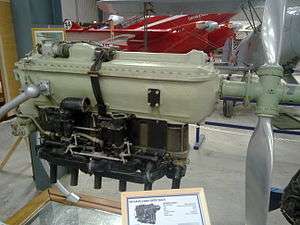
Data from De Havilland Aircraft since 1909[21]
General characteristics
- Crew: two
- Length: 29 ft 0 in (8.84 m)
- Wingspan: 44 ft 0 in (13.41 m)
- Height: 10 ft 0 (3.05 m)
- Wing area: 212.5 sq ft (19.75 m2)
- Airfoil: RAF 34[22]
- Empty weight: 2,930 lb (1,332 kg)
- Loaded weight: 5,550 lb (2,523 kg)
- Powerplant: 2 × de Havilland Gipsy Six R six-cylinder air-cooled inverted inline engine, 230 hp (172 kW) each
Performance
- Maximum speed: 237 mph (206 kn, 382 km/h)
- Cruise speed: 220 mph (191 kn, 354 km/h)
- Stall speed: 74 mph (64 kn, 119 km/h) [23]
- Range: 2,925 mi (2,541 nmi, 4,710 km)
- Service ceiling: 19,000 ft (5,790 m)
- Rate of climb: 900 ft/min (4.6 m/s)
In popular culture
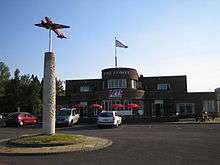
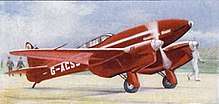
The Comet hotel, Hatfield has a 9 feet (2.7 m) carved column in its car park, designed by the war artist Eric Kennington and erected in 1936.[24] On its top is mounted a famous model of the Comet, currently in the livery of Grosvenor House.[25]
Grosvenor House and Black Magic, together with their crews, feature prominently in the 1990 TV two-part dramatisation Half a World Away made in Australia and also sold as The Great Air Race.
In the film Planes from DisneyToon Studios, the character Bulldog is based on the Comet and is voiced by the comedian and actor John Cleese.[26]
In the Dutch aviation comic series January Jones the title heroine, a U.S. racing pilot in the 1930s, flies her own Comet, usually indicated as (De Havilland) Comet. Its red finish with white trim and race number 43 resemble Grosvenor House. The series has been published in Dutch, French, Danish, Norwegian, Finnish, Portuguese, Catalan, Spanish and German.
The American comic strip The Phantom began a storyline on 2 July 2016 which featured a Comet, describing it as one of the original race machines, restored after a hangar fire in France in June 1940.
See also
Aircraft of comparable role, configuration and era
References
Notes
- ↑ Lewis 1970, p. 257.
- ↑ Jackson 1987, p. 356.
- ↑ "The England–Australia Race: £10,000 for Fastest Flight from London to Melborne". Flight, Vol. XXV, No. 1284, 3 August 1933, p. 770.
- ↑ Ogilvy 1988, p. 16.
- ↑ Ogilvy 1988, p. 19.
- ↑ Flight, 18 Jan 1934, p. 59. "...that a limited number of these machines will be built, and that the price will be £5,000. A deposit of 20 per cent. will be demanded with the order, and the company will guarantee a top speed of at least 200 m.p.h. If that speed is not attained, the customer will be at liberty to cancel his order, and all money paid by him will be refunded. In order to ensure ample time for development and tests, it is pointed out that instructions to begin construction should be placed before the end of February."
- 1 2 3 4 Ogilvy 1988.
- ↑ Ogilvy 1988, p. 155.
- ↑ Ogilvy 1988, p. 16.
- ↑ Ogilvy 1988, pp. 17–18.
- ↑ Winter, H.T. Flight Today and Tomorrow. 1st Edition, Blackie, ca. 1949. p. 232.
- 1 2 "Airscrew Development". Flight: 501. 15 December 1938.
- ↑ "Clouston's fine flight." Flight, 24 March 1938. Retrieved: 25 June 2012.
- ↑ "Highest, fastest, farthest ... Place-to-place records: Category 2 (Pilot and passengers)." Flight, 5 January 1950. Retrieved: 25 June 2012.
- 1 2 Ricco 2010, p. 34.
- 1 2 3 4 5 Phillippe Ricco; "Les de Havilland DH-88 «Comet» Français", Avions, Issue 168, March/April 2009, pp. 32–42. (in French)
- 1 2 Paul Badre, "Les Cometes", Aeroplane Monthly, January 1983, Pages 44–47.
- ↑ Michael Clegg; “de Havilland Aviation Museum review”, Part II, Airfix Aerodrome blog, 4 May 2018. (retrieved 4 May 2018)
- ↑ “Restoration.” Light Aviation, November 2011. pp. 16–19.
- ↑ "Update on Sister Project: G-RCSR Replica Build January 2017." Comet Racer Project Group, Retrieved: 15 May 2017.
- ↑ Jackson 1987, pp. 360–361.
- ↑ Jackson 1987, p. 357.
- ↑ Taylor 1979, p. 55.
- ↑ Jonathan Black; The Face of Courage: Eric Kennington, Portraiture and the Second World War, Philip Wilson 2011, p.18.
- ↑ J.M. Ramsden; "Comet G-ACSS Reborn", Aeroplane Monthly, August 1982, p.412. "The Comet pub, just outside Hatfield aerodrome, with its famous model of Comet G-ACSS"
- ↑ Goldberg, Matt (26 March 2013). "New Images and Full Voice Cast for PLANES Announced; Includes Val Kilmer, Anthony Edwards, Julia Louis-Dreyfus, John Cleese, and More (UPDATED)". Collider.com. Retrieved 31 March 2013.
Bibliography
- Jackson, A.J. De Havilland Aircraft Since 1909. London: Putnam, Third edition, 1987. ISBN 0-85177-802-X.
- Lewis, Peter. British Racing and Record Breaking Aircraft. London: Putnam, 1970. ISBN 0-370-00067-6.
- Ogilvy, David. DH88: deHavilland's Racing Comets. Shrewsbury, Airlife, 1988. ISBN 1-85310-011-0.
- Ramsden, J.M. "The Comet's Tale – Part 2". Aeroplane Monthly, Vol. 16, No. 5. May 1988. pp. 279–283. ISSN 0143-7240.
- Ricco, Philippe. "La Comète en France, Part 1", Aeroplane Monthly, Vol. 35, No. 439. November 2009.
- Ricco, Philippe. "La Comète en France, Part 2: The Burden of Proof". Aeroplane Monthly, Vol. 38, No. 449. September 2010.
- Sharp, C. Martin; DH: An Outline of de Havilland History. London, Faber & Faber, 1960.
- Taylor, H.A. "The First "Wooden Wonder"". Air Enthusiast, Ten, July–September 1979. pp. 51–57.
External links
| Wikimedia Commons has media related to De Havilland DH 88 Comet. |
- Comet Racer Project Group
- The Burberry Comet Racer Project, Sywell Aerodrome.
- Sound recording of G-ACSS, Aircraft Sound Recordings.